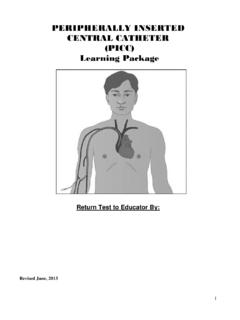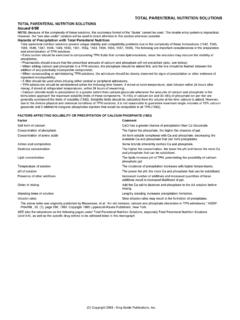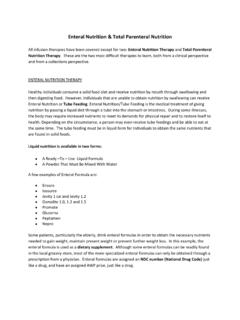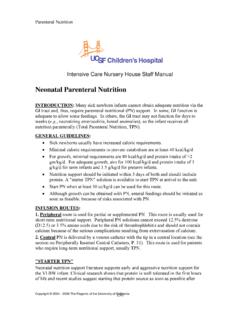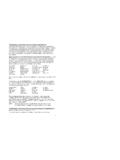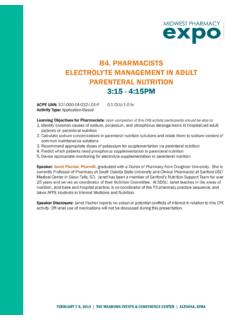Transcription of TOTAL PARENTERAL NUTRITION - nygh.on.ca
1 TOTAL PARENTERAL NUTRITION (TPN)Revised January 2013 OBJECTIVES Definition Indications for TPN administration Composition of TPN solutions Access routes for TPN administration Monitoring TPN administration TPN administration practice guidelines Fluid management with TPN Complications of TPN DocumentationUnderstanding TPNWHAT IS TPN ? Definition: The administration of a nutritionally adequate hypertonic solution consisting of dextrose, amino acids, protein, minerals, fats, vitamins and trace elements through an intravenous FOR TPN ADMINISTRATION Small bowel ileus High output fistula >500 mls/day Mechanical small bowel obstruction Bowel infarction/bowel ischemia Inability to tolerate enteral feedingCOMPOSITION OF TPN solutions Lipids One solution 20% at NYGH Electrolytes Standard electrolytes.
2 Na, K, Ca, PO4, Mg, Cl, Acetate Vitamins MVI-12 Minerals Zinc, copper, manganese, selenium, chromiumTYPES OF TPN solutions LOW CONCENTRATION < 10% dextrose, Amino Acids Peripheral solutions Usually through 18 gauge [pink] angiocath HIGH CONCENTRATION > 10% dextrose, Amino Acids Central Venous solutions Through PICC, CVC site ONLYACCESS ROUTESFOR TPN ADMINISTRATIONP eripheral Lines Arm veins TPN expected to run < than 2 weeks For < 10% dextrose solution ONLYACCESS ROUTESFOR TPN ADMINISTRATIONP eripheral Line complications: Phlebitis Thrombophlebitis Infiltration Extravasation Occlusion PainACCESS ROUTESFOR TPN ADMINISTRATIONC entral Venous Catheters The subclavian or internal jugular vein is catheterized Used when peripheral veins are unsuitable Used when patient requires high concentration solution for high energy requirements ACCESS ROUTESFOR TPN ADMINISTRATIONC entral Line complications.
3 Sepsis Pneumothorax EmbolismACCESS ROUTESFOR TPN ADMINISTRATIONP eripherally Inserted Central Catheters (PICC) Inserted into the basilic or cephalic vein then threaded up toward the heart into the right subclavian vein TPN expected to run > 1 wk Infuse either central or peripheral solutionACCESS ROUTESFOR TPN ADMINISTRATIONPICC Line complications Catheter occlusion (frequent) Sepsis Pneumothorax EmbolismMULTIDISCIPLINARY TEAM APPROACH Physician orders TPN due to clinical presentation Dietitian recommends type of TPN or verifies TPN prescribed Pharmacydispenses TPN ordered Nursing administers/monitors patient responseMONITORING TPN ADMINISTRATIONB efore starting Obtain patient s weight Obtain baseline blood work including blood sugar to establish hepatic and renal function Fax order to pharmacy before 11 amMONITORING TPN ADMINISTRATION During TPN therapy, Standard TPN Bloodwork.
4 Electrolytes, urea, creatinine, Ca, Mg, PO4, Alb, TG, glucose, ALP, AST, ALT, Cholesterol, Bilirubin, Platelets, INR, PTT Glucometer BID until BS <7, then as ordered Patient s Weight Intake and output IV, PO, CT, NG tube, fistula, urine, BM, ostomy, surgical drainsTPN ADMINISTRATION PRACTICE GUIDELINES Double check physician s orders with TPN pharmacy labels Document on eMAR record by scanning barcodes on TPN bags when hanging Practice aseptic technique for IV therapy Clean ports with 2% chlorhexidine gluconate with alcohol wipes Document volume infused on Intake and Output form every 8 hoursTPN ADMINISTRATION PRACTICE GUIDELINES Alwaysinfuse TPN with aninfusion pump Change TPN tubing every 24 hours (daily at 1400) Monitor for signs & symptoms of complicationsFLUID MANAGEMENT WITH TPNT otal Fluid Intake (TFI)
5 Identified in a physician s order Prescribed to prevent fluid overload The amount of fluids (continuous IV, Travasol, lipids, medications) received by the patient Described in mL/ hourFLUID MANAGEMENT WITH TPNHow do you maintain the TFI ordered in the following scenario? Patient is post-op day 3 with an ileus and is prescribed TPN. This patient is receiving an IV R/L @ 80 ml/hr and is prescribed Travasol @ 1500 mL/24 hours and Lipids @ 250 mL/12 hours. The TFI ordered is 125 MANAGEMENT WITH TPNTo get the TFI, manipulatethe IV rate. Travasol rate/hour ? Lipids rate/hour? TFI (Travasol + Lipids) Change IV rate to equal TFI Document all rates and volumeson Powerchart 1500/24 = 250/12 = 125 (63 + 21)
6 = 125 84 = 41 IV rate from 80 to 41mL/hr when lipids are runningCOMPLICATIONS ASSOCIATED WITH TPN THERAPYC omplications relatedto administration Sepsis Pneumothorax Embolism Catheter occlusion Fluid overload or pulmonary edemaComplications related to composition of the solutions Metabolic disturbances Hypo/hyperglycemia Hypo/hyperkalemia Hypo/hypercalcemiaDOCUMENTATION OF TPN Verify physician s TPN orders Document TPN administration on eMAR by scanning with Caremobile Document TPN volumes on Intake and Output powerformeCARE DOCUMENTATION OF TPN VOLUMESeCARE DOCUMENTATION OF TPN ADMINISTRATIONSUMMARY TPN is ordered to meet nutritional needs Hypertonic IV solution consisting of glucose, protein, minerals, fats and vitamins given intravenously Peripheral, CVC, PICC preferred Monitor body s metabolic status- glucometer, daily lab work Documented on eCareREVIEW QUESTION 1 What would happen if the <10% concentration TPN solution was administered through a PICC or CVC site?
7 Is this safe or unsafe for the patient?REVIEW ANSWER 1 Administering <10% concentration TPN solution through a PICC or CVC site is safe. Sometimes it is preferred for patients with poor peripheral QUESTION 2 TRUE OR FALSE?The best route for TPN administration is through a PICC ANSWER 2 TRUEREVIEW QUESTION 3 TRUE OR FALSE?Bloodwork/monitoring is required only once TPN solution has ANSWER 3 FALSEREVIEW QUESTION 4 TRUE OR FALSE?In order to process a TPN order, the pharmacist must receive the order by 11 ANSWER 4 TRUEQUESTIONS ?

